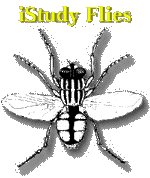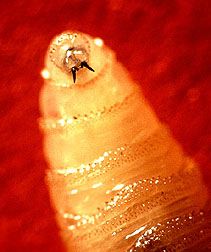
|
iStudy Flies - Beneficial, Medical Use of Maggots
BENEFICIAL, MEDICAL USE OF MAGGOTS
In 2005, Maggot Debridement Therapy (MDT) employs live maggots -- fly larvae from the blowfly, e..g., Phaenicia sericata (green blowfly) -- for cleaning non-healing wounds. These are called "medicinal maggots" because they: (1) debride (clean) wounds by dissolving dead and infected tissue, (2) disinfect wounds by killing bacteria, and (3) stimulate wound healing. [51] Modern maggot therapy was performed by Dr. William Baer, an orthopedic surgeon, at Johns Hopkins University prior to 1931, but antibiotics and surgical techniques superseded their use after World War 2. Since that time, those antibiotic medical modalities have occasionally failed. Consequently, since 1989, physicians at the Veterans Affairs Medical Center (Long Beach, California) and the University of California, Irvine have sought to employ maggot therapy for patients before it became a last resort. [52] The promotion of healing wounds that are not responding to conventional antibiotics, and the prevention of amputation, are goals for the Maggot Debridement Therapy (MDT), for that reason, the physicians and researchers of the Maggot Therapy Project have assembled a web site: (1) to explain the "Clinical Practice of Maggot Therapy" to inquiring physicians and patients through downloadable documents, e.g., "Information Sheet and FAQ for Health Care Providers," [53] (2) to promote the use of University of California, Irvine laboratory produced, FDA approved Medical Maggots as a medical device -- 510(k) #33391 -- since January 2004, (3) to provide links to further information on the topic of using living organisms in medicine, and (4) to keep the topic of Maggot Therapy alive by posting links -- toward the bottom of their Home Page -- to "Press Articles" to be found on the Internet. [54]
|
Member of Fohn.net
